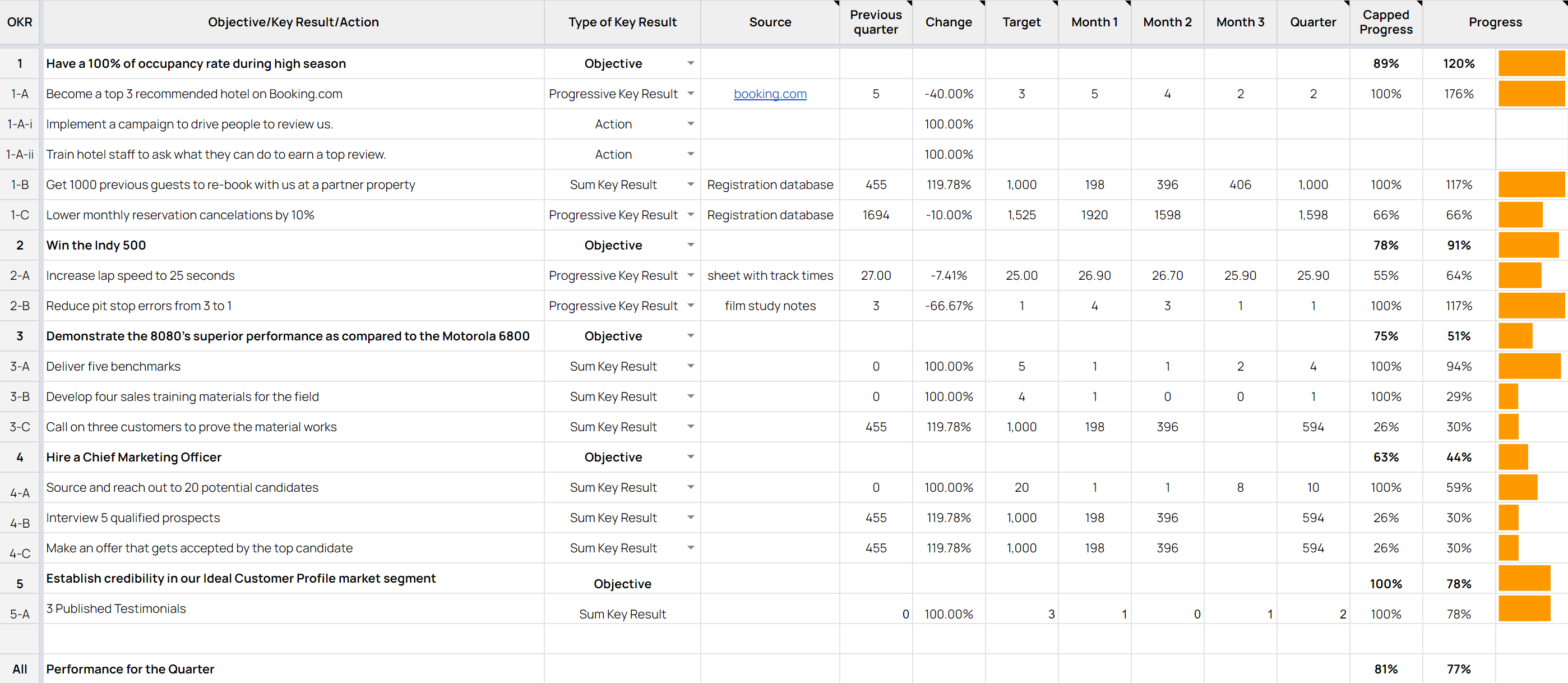Most of the B2B SaaS marketing teams I've worked with use a quarterly based priority system for their marketing goals. If they don't, I recommend they start using one to monitor and evaluate progress over time.
The following is all you need to get started. A template, examples, and a set of educational resources.
OKR stands for objectives and key results. I like to add one more element: the actions you'll take to accomplish your key results and objectives.
Objective
- Why is your (team's) role important? List 3-5 Core Objectives.
- Objectives can stay the same from one Quarter to the next.
- You can base your OKRs on your annual priorities, for example as created by using the T2D3 Growth Matrix planning exercise.
Key Result
- What's the ideal outcome of doing the work? Limit to 3 Key Results per Objective.
- How do you know you've achieved the Objective?
- What does a successful quarter look like? How to “keep score”?
Actions
- How will you drive the Key Results and achieve the Objective? If you have too many KRs, consider some of those might really be actions with milestones throughout the quarter.
- What are we executing to support the Objectives and achieve the Key Results?
- These are your leading indicators and warrant managing against on a weekly basis.
When?
OKRs are easy to understand and learn, and other management systems like Traction/EOS (based on the Rockefeller Habits) use a similar Quarterly Focus (i.e. Quarterly Big Rocks). Changing your B2B marketing OKRs every quarter works well in startups, where the company will change a lot in a year, and annual goals are just too far away. The quarterly planning focus balances the need for prioritization and focused execution, with the reality that needs will change fast in a growing SaaS Startup.
If you are an OKR expert, and just want the template, click below (available for T2D3 Pro members only). Read on if you want to be trained including a short video course.

Getting started with OKRs
In the member section of T2D3, you can find Lecture 4 of the T2D3 Masterclass Series, “Managing Marketing Tactics”, as a deep dive into creating, using, and managing OKRs for a B2B SaaS Company. Here is a sneak peek of the content:

Example SaaS Marketing OKRs
Here is an example list of excellent OKR examples for a typical B2B SaaS marketing leader (or team). The bullets under the Key Results are Initiatives (or Actions) to achieve the Key Results. You should change these if they don't get the results you want:
- Objective: Drive demand for our products and services
1.1. Key Result: Grow sales funnel with XX new SQLs
1.1.1. Increase conversions to SQLs through A/B testing
1.1.2. Drive “meetings happened” focus with Sales
1.2. Key Result: Drive YY new MQLs
1.2.1. Execute ABM campaigns to 2 specific verticals
1.2.2. Optimize prospect/lead nurture campaigns
1.2.3. Improve channel attribution to drive optimization
1.3. Key Result: ZZ new subscribers (opt-ins)
1.3.1. Launch holistic content marketing
1.3.2. Confirm a CTA on all content
1.3.3. Improve top 10 landing pages on-page SEO
1.3.4. Drive off-page SEO from partner properties
- Objective: Build a growth flywheel
2.1. Key Result: One new customer from a referral program
2.2. Key Result: X meetings happened from organic search
2.3. Key Result: Optimize CTAs on top 5 content pieces
- Objective: Build a new GTM for a new niche
3.1. Key Result: ICP completed & TAM/SAM/SOM defined
3.2. Key Result: Publish 2 new testimonials from the ICP
3.3. Key Result: XX list targets acquired with validated email addresses
- Objective: Improve return on marketing spend (ROMI)
4.1. Key Result: Lower customer acquisition cost to <$XX
4.2. Key Result: Get cost/MQL below $XX
There are many SaaS Tools that help you to track OKRs and the weekly execution of Initiatives (like Weekdone ). When you just get started though, a simple list in a Google Doc or a spreadsheet that can be easily shared with the team works well too. Keep it simple! Don't get bogged down in the process, get frustrated, and abandon the effort.
The next template can help you get started. If you're managing across a few departments, you might want a more comprehensive OKR management tool.
OKR Template for B2B SaaS
To get you started with creating your own OKRs, here is a template that you can use. It's just been made available to Pro members only. View membership tiers. The following video walks you through using it:
You can find more templates on the T2D3 Resources page.
If you are new to this topic and want to learn more about OKRs, please check out the following resources:
- Podcast: BSMS 11: What OKRs should your marketing team use?
- Article: Managing your B2B SaaS Marketing Team
When you create your first OKRs, consider matching them with the maturity of your B2B SaaS marketing team:
A framework to help you set marketing OKRs depending on the maturity of the function
READ ARTICLE
The playbook to finalize your plan
Here you can find B2B SaaS playbook (bottom of page), and other templates to scale a fast-growing software venture. The playbook helps you with the right sequence and checklist of activities and priorities. The playbook is based on building marketing teams and coaching the marketing leaders at a combined 100 companies. The playbook will help you do the right things in the right order, at the right time, and can be a great resource to train your team on tactics they do for the first time.